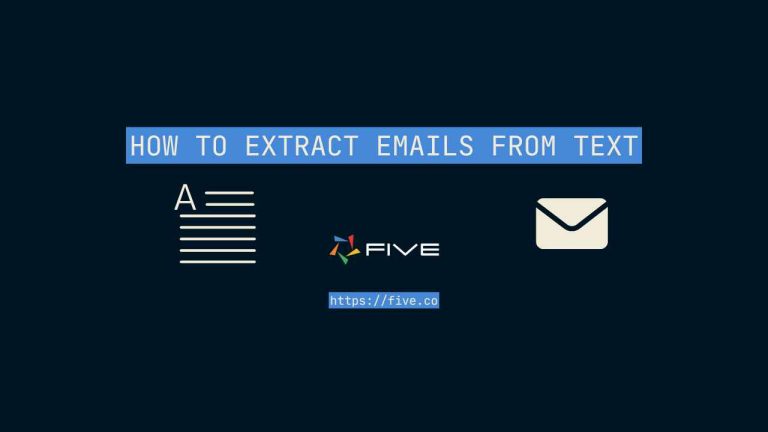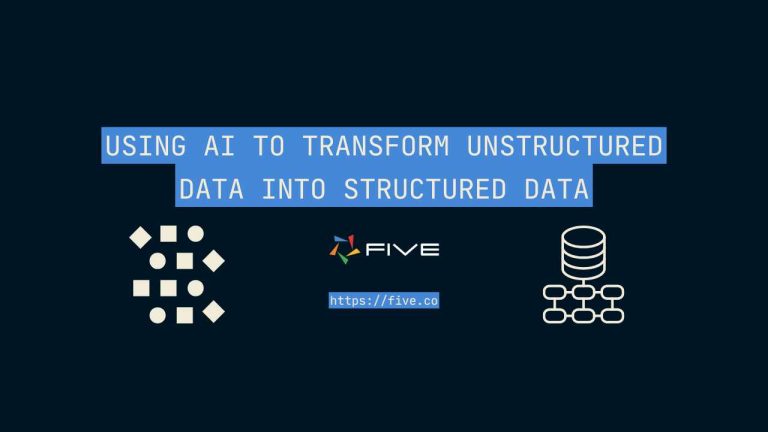The Only Caspio Alternative You Need to Know in 2024
Rapidly Create Database Applications With This Affordable Caspio Alternative
“No Code, Just Caspio” – that’s what Caspio, a popular online database solution, promises to its users. In this article, we put the company’s slogan to the test, and see how Caspio stacks up against popular Caspio alternatives for rapidly building custom database applications.
This article is for those looking for an affordable and easy-to-use Caspio alternative to rapidly build and launch database applications, such as custom business apps, customer relationship management, or membership systems, for example.
TL/DR: Here’s our recommendation for a Caspio alternative with affordable monthly subscription plans. Try Five, a flexible online database builder providing a customizable MySQL database and attractive monthly hosting plans starting from just US$27.49 per application and month.
Caspio, Five and Knack: Online Database Builders

Caspio, Five, and Knack are all “apps that built apps”. They give users:
- access to a hosted, relational database to store data,
- provide front-end user interface design capabilities, and
- provide managed application hosting to run applications online.
Let’s check out each platform and find out how they compare.
Caspio vs. Knack vs. Five: Summary Comparison
| Caspio | Five | Knack | |
| Pricing | Starts from US$100 per month | Starts from US$27.49 per month | Starts from US$39 per month |
| Limitations | Data Pages | Storage | Storage & Records |
| Type of Application | Embeddable Web Widgets Only | Full-Stack, Responsive Web App | Full-Stack, Responsive Web App |
| Development Style | No- and Low-Code | Low-Code | No-Code |
| Underlying Database | Microsoft SQL Server | MySQL | Proprietary Relational |
| Ability to Write SQL | Partial | Yes | No |
| Hosting Partner | AWS | Azure | AWS |
| Free Version | 14 Days | Full-Featured Free Download | 14 Days |
What is Caspio?

Caspio is a model-driven, low-code web application platform, created in 2000 by software entrepreneur Frank Zamani.
Caspio combines familiar elements of Microsoft Access, a desktop database builder, with web application development. The solution covers the entire process from database creation to application deployment.
Caspio is made for tech-savvy business users. The solution does not presume prior knowledge of programming, but an understanding of relational databases, database tables, data types, or relationships is a plus.
It is a popular solution for small- and medium-sized businesses that require web-based database applications, online forms connected to a database, or simple data visualizations (charts and dashboards).
What Caspio’s Users Say
Caspio is one of the pioneers in low-code application development. The company brought MS Access and database application development to the web.
Caspio has a loyal user community who praise the product for its intuitiveness, its visual application development features, and comprehensiveness. Its more than 20 years of history gives the company a foothold in many different industries, and its marketplace provides users with pre-built templates, extensions, and data sets to get started quickly.
However, the company’s slogan – “No Code, Just Caspio” – seems to suggest that Caspio is a solution for everyone and that no background in software development is required to build applications with Caspio. This is true to a certain extent, but some users report that the learning curve for using Caspio can be steep.
Simple form-based applications can be built with Caspio very quickly and entirely in point-and-click. However building more complex applications typically requires a solid understanding of common programming concepts, such as relational databases, HTML, JavaScript, or SQL.
Negative reviews of Caspio usually concern three things: its pricing, its limitations, and its deployment model. Let’s start with pricing first.
1. Caspio’s Pricing Starts at US$100 per Month
Caspio’s most affordable plan – the Starter plan – starts at a regular price of US$100 per month. This makes Caspio relatively expensive. Five, for example, charges just US$27.49 per month and application.
The company does offer promotions to new customers, who can benefit from a 50% discount, but it is not clear how long the discount is valid.
Caspio offers a free trial that is time-limited to 14 days.
2. Caspio’s Pricing and “Data Pages”: The More Complex Your App, The More Expensive
When buying something, it is usually helpful to compare alternatives. For example, one laptop may offer 256GB of storage, another 512 GB. Gigabytes are easily understood, easily comparable, and standard across all laptops. This is unfortunately not the case when evaluating Caspio. Caspio uses a proprietary metric, something called data pages, to limit application complexity.
Explainer: What is a Caspio Data Page?

Here is Caspio’s definition of a data page: “DataPages are user interfaces of your application, such as web forms and search/display interfaces. Apps are for the most part a collection of DataPages that are designed to provide the functionality of the app for the end users.”
The image above explains the concept of embeddable data pages. They are web elements published onto an existing web page, blog, or canvas and they are connected to your Caspio-managed database.
Data stored in an application built with Caspio resides in a SQL Server database, hosted on AWS.
Caspio’s focus on embeddable web widgets is not necessarily a disadvantage and can be a good option for all those who want to leverage an existing website. However, be aware that embedding external widgets into an existing website can lead to slower loading speeds and penalize your search rankings.
To evaluate Caspio’s pricing, you should assess how many data pages your application will have. First-time users of Caspio dislike this concept, as even with Caspio’s definition of a data page, it is almost impossible to make a precise estimate upfront.
A useful workaround is to check out Caspio’s existing app templates. For example, the CRM system demoed in this Caspio walkthrough has 24 data pages. Caspio’s Starter Plan, however, includes only 20 data pages.
Once your application has more than 20 data pages, you’ll need to upgrade to Caspio’s Professional plan at US$600 per month.
Before using Caspio, it is worth understanding pricing, what data pages are, and how this will affect the monthly cost of running your application.
3. Launching Your Caspio Application Requires an Existing Website
Last, let’s speak about application deployment, or how to get your application to its end-users.
To deploy an application built in Caspio, you usually require an existing website built in WordPress, Weebly, or Webflow.
The parts developed in Caspio – such as forms, charts, or reports (the data pages) – can be embedded into your existing website’s source code, by copying a snippet of JavaScript code into your website builder.
As such, Caspio is not used to build stand-alone web applications. Instead, it is used to develop embeddable web widgets. Caspio does not provide a custom URL for your end-users to access the entire application (individual data pages can be accessed via unique URLs).
In addition, this means a paid subscription to a website and hosting provider, such as WordPress, Weebly, or Webflow is required to get your application to its end-users.
Last, some JavaScript and HTML knowledge is require to embed your widgets into your existing website. This is not complicated, but if you are intimidated by code, then this might not be for you.
The Only Caspio Alternative You Need to Know: Five
Let’s move on and explore a powerful Caspio alternatives, Five.
There are plenty of other Caspio alternatives that users can choose from, such as Knack, FileMaker, Zoho Creator, or any other online database builder.
Five is an affordable database application builder with powerful low-code features for writing SQL or building MySQL database. .
What is Five?

Five is a low-code development environment that helps build and deploy online database applications.
Just like Caspio, it provides users with many useful visual application development features, such as a drag-and-drop database designer, a visual query builder as well as form and chart wizards.
Five also provides extensibility through standard SQL, JavaScript, or TypeScript. For example, it comes with very powerful querying capabilities, which can support custom reports, charts, or forms.
To see how Five works, check out this video that converts a spreadsheet into a web-based database application.
Five builds applications on a standard MySQL database, which keeps your data portable and reduces vendor lock-in.
1. Five is More Affordable Than Caspio: Deploy Apps From Just US$27.49 per Month
Five has a simple and transparent pricing model. Developers pay a fixed fee per application and month. A single application on Five’s annual Basic Plan costs just US$27.49 per month.
Five also offers a full-featured free download, that lets developers build and test their applications locally free of charge.
2. Five’s Plans Provide Flexible Online Storage
Most developers of data-driven web applications only care about one question: how much data can my application store, expressed in GB?
Five offers three different plans for application hosting (all plans are for a single application with unlimited end-users). Its Basic Plan includes 3 GB, its Team plan includes 20 GB, and its Business Plan includes 100 GB of storage.
The concept of data pages doesn’t apply to Five. Applications can be as complex as necessary – the only thing that counts is storage.
3. Five Builds Full-Stack Web Apps
Is your plan to build a standalone web application rather than just widgets? Then Five is the right solution for you. On the surface, both Caspio and Five seem very similar, as both are purpose-built for creating business applications: custom CRM systems, customer portals, inventory management systems, or customer registration forms.
However, unlike Caspio, Five lets users build a standalone web application with its unique URL, logins, and user management. Apps developed in Five do not require a third-party web hosting provider to run online.
Other Caspio Alternatives

There are a lot of other Caspio alternatives, from Tadabase to Knack. Let’s take a quick look at Knack, which is popular as a no-code Caspio alternative for building data-driven applications visually.
Unlike Five, Knack is primarily a no-code solution designed for use by people without any background in application development.
Knack is a visual, WYSIWYG application builder that simplifies application development and deployment. Users praise Knack for its simplicity, useability and its pixel-perfect front-end capabilities.
Unlike Caspio or Five, Knack lets users build applications on a proprietary, relational database that is hidden behind Knack’s visual database designer.
Knack replaces programming terminology with its own set of terms. For example, instead of speaking of relationships between tables, Knack lets users build connections. Instead of database tables, users build objects.
This language is unique to Knack and makes the solution seemingly more intuitive to non-programmers than Caspio or Five.
For those who are already familiar with relational databases or SQL, Knack’s choice of words means re-learning what they know already. In the long-term, learning Knack also does not put you on a path of learning proper database modeling in SQL, a widely-used and useable skill in programming.
Knack is generally considered to be an entry-level solution, and its data modeling and querying capabilities are not as advanced as Caspio’s or Five’s.
One big drawback of using Knack is that the solution does not give users any kind of sandbox environment for their applications. This means that any changes to your application are directly pushed to your production version, which is risky and does not correspond to best practices in application development.
1. Knack is Cheaper Than Caspio But More Expensive Than Five
Knack is much more affordable than Caspio, but more expensive than Five on its cheapest plan. For US$39 per month, Knack gives users 2B of storage or 20,000 records.
Knack’s entry-level plan includes three applications, which makes it cheaper on a per-application basis, but at just 20,000 records (or 6,666 records per application), there’s not much space for each application.
The company also offers a time-limited free trial (14 days).
2. Knack Limits By Storage and Database Records
Knack is generous when it comes to its inclusions regarding the number of applications: its US$39/month plan lets users build a maximum of 3 apps, and its Pro Plan at US$79 per month includes 8 apps already.
However, the Starter plan only includes 2 GB of storage, making Knack the least attractive choice for an online database. For US$79 per month, users get 10 GB of storage, a maximum of 50,000 records, and can build up to 8 apps.
Five: The Modern Caspio Alternative
In this article, we compared popular online database application builders. Caspio and Five are comparable in many ways, with some unfair advantages for Five. Five builds stand-alone applications rather than widgets, and has a lower cost of ownership compared to Caspio’s pricing.
Five is a low-code solution that unlike other Caspio alternatives, such as Knack, does not try to “hide” or “explain away” core programming concepts. Five comes packed with a customizable MySQL database, powerful querying capabilities and point-and-click form, chart and report wizards.
Another key difference between Caspio and its alternatives is pricing and limitations. Caspio limits applications by data pages. Five limits by storage (in GB), and Knack limits by records and storage. Five is the most affordable Caspio alternative, with its lowest plan starting at just US$27.49 per month/app.


